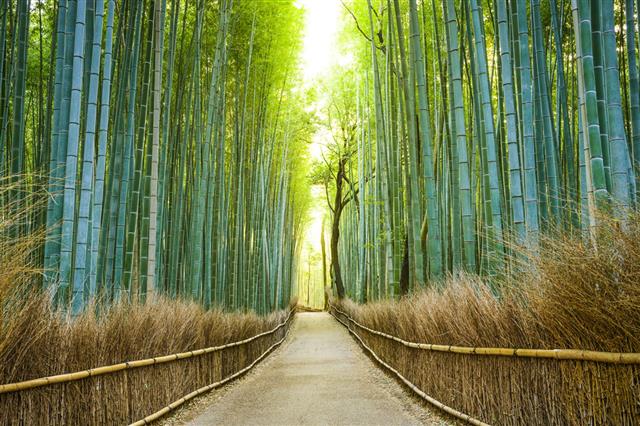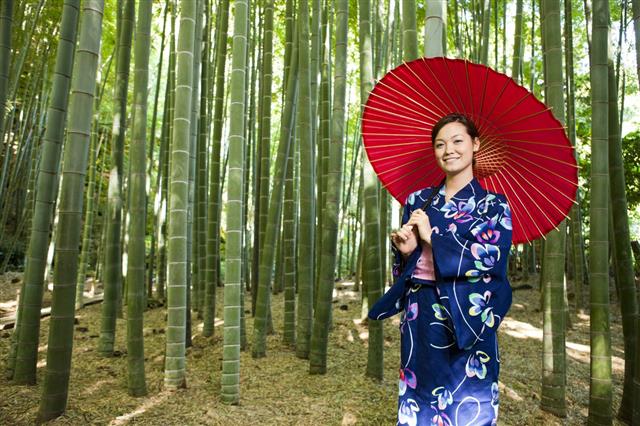
With numerous slender stems and green feathery fronds, bamboo palm plants can literally change the atmosphere of the room. Gardenerdy provides tips on bamboo palm care. Read on to know some simple rules of culture, if you want to grow them indoors.
Did You Know?
A study sponsored by NASA showed that houseplants are capable of purifying air by removing harmful chemical toxins like benzene, formaldehyde, and trichloroethylene from it. According to NASA, to clean the air, we should have at least one plant per 100 sq. ft. Bamboo palm is considered as one of the best clean air plants.
The genus Chamaedorea consists of 107 species of small palm trees. They are commonly found in the understory of rainforests in Southern Mexico and Guatemala. They are popular as garden trees and indoor plants. All Chamaedorea are pinnate leaf (feather leaf) palms. They don’t have fan-type leaves. The color of the crownshaft (tubular structure or base of a leaf stem) is typically green. The species from the genus Chamaedorea are commonly referred to as ‘bamboo palm’.
The classic bamboo palm plant, ‘Chamaedorea seifrizii‘ (also known as the reed palm), is a slow growing plant. It is native to tropical and subtropical regions of South Americas. This popular house plant is a suckering species (multi-stem palm). It naturally produces more than one vertical stem or trunk. Although new trunks emerge from the bottom of the first trunk and grow, the first trunk, the tallest of all trunks until the plant reaches maturity, is easily detectable. New trunks continue to form throughout its life. However, formation of new stems may slow down over time. An outdoor plant can be 10-15 feet tall. It can be 4-6 feet tall indoors, with a spread of around 3 to 5 feet. These plants are perfect for any yard size and are cultivated outdoors across U.S.D.A. plant hardiness zones 8 through 11.
Choosing a Bamboo Palm Plant
Best Species
➺ One of the most commonly grown bamboo palm species ‘Chamaedorea seifrizii‘ is prone to fungal infections. Moreover, with very few leaves, it can become lanky over time. Due to lack of vigor, it produces short unattractive leaves. A young plant may look attractive, but, over time, it won’t be able to maintain the beauty. So, always choose the species carefully. Chamaedorea hooperiana, Chamaedorea microspadix, Chamaedorea costaricana, Chamaedorea cataractarum, etc., are some superior suckering Chamaedorea species. Chamaedorea elegans, that grows up to 9 feet, is commonly known as the good luck palm or the parlor palm. Chamaedorea microspadix is the most cold hardy of these species. These days, various hybrid varieties are available in nurseries.
How to Care for Bamboo Palm Plants
Light Requirement
➺ Bamboo palm plant prefers minimal sunlight. It likes indirect, filtered light or shade. Certain species can tolerate some sunlight, but if you suddenly bring a houseplant outdoors, then such drastic change can damage the plant seriously. You may expose the plant to more light gradually.
Temperature Requirement
➺ The plant grows well in temperatures between 65-80 degrees.
Humidity Requirement
➺ It requires medium to high humidity.
Soil Requirement
➺ The plant will grow well if the soil is rich in organics, and if it is well-drained. You may add mulch, fir shavings, compost, etc., to sandy or clay soil to improve its quality.
➺ Adding some pumice or large-grain sand to the soil can make it well-aerated and can promote quick drainage. The soil should retain some water too. Use a well-drained, peat-based potting mix.
Water Requirement
➺ Regular watering is essential in the initial stages, during active growth. Fully grown plants can be watered occasionally. You may water the plant less frequently during fall and winter, but do not let the plant dry. Soggy soil leads to root rot, just keep it moist. Water the soil only when it looks dry. You may water the outdoor plants once a week or three times a week, if the weather is warm.
Fertilizers to be Used
➺ A slow-release or diluted liquid fertilizer like 15-5-15 can be used for indoor plants during active growth. You may apply it once in a month.
➺ For outdoor plants, you may use a slow-release fertilizer like 8-2-12, rich in manganese and other essential micronutrients. You may apply it every three months during active growth (read the instructions on the label and follow them strictly.)
➺ Excessive use of fertilizer can lead to accumulation of salts in the soil. The leaves may turn brown, as a result.
Pruning
➺ Pruning of bamboo palm plant involves cutting the brown leaf tips, and removing yellowing or dried fronds and bare stalks. Cut off the dead or wilted leaves from the base of the stem.
Pest Control
➺ The plant usually has no major pest or disease problems. Regular monitoring for damaged stems or leaves and pests, such as scales or mealybugs can help avoid serious conditions. If you notice mites, especially on the underside of leaves, add some soap to water, and wash the leaves with this soapy water. For limited mealybugs infestation, pruning the damaged portions, or cutting the damaged leaves right from the base at the stem is sufficient. If the problem persists, you may have to remove entire problematic stem.
Indoor Plant Care
Tips
➺ It is better to buy an established plant than trying to propagate a bamboo palm plant from seeds. It might take 2-5 years to grow a 2-4 feet tall plant from seeds.
➺ Do not keep these plants in front of a window, to avoid exposure to bright sun. Indirect light is sufficient for them. Excessive exposure to natural light can cause the plant’s leaves to scorch and burn.
➺ If you are using a furnace during winter, do not forget to spray water and cover the plant with mist. Low humidity can lead to leaf burning (starting from the tip). This way, you can prevent the leaves from turning brown. To avoid loss of fronds, place an indoor plant in a southeast-facing window of your home.
➺ Keep the plant away from heating or cooling vents.
➺ Tap water is often high in salt content. It can damage the plant over time. So, provide the plant distilled water or water from a reverse osmosis unit. If you cannot do this, then shift the plant outdoors occasionally, especially during monsoon, so that the accumulated salt is flushed away. At least once in six months, water the potted plant with large amounts of water, allowing the excess to run out the drainage holes.
➺ When the roots come out of the drainage holes, they can suck the drainage water in a saucer that is usually kept below the pot. This drained water can be high in salts and can damage the plant. So, fill the saucer with gravel, and place the pot on the gravel above the drainage water, not in it.
➺ If you are going to prune the plant, first fertilize it and then, after a week or so, prune it. This will promote quick growth at the pruning cut.
➺ Repot the plant when it becomes too large for its container.
According to the ASPCA’s Poison Control Center, bamboo palm trees are non-toxic to cats and dogs. However, according to some experts, the berries that are produced by some palm species can be toxic for pets. Indoor bamboo palms can prove soothing for the eyes; however, it is necessary to collect information on plant care before buying a plant.

